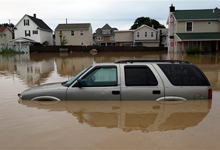Newspapers spend a lot of time and energy erecting website paywalls, but are they thinking enough about when to take them down?
Even if a publisher commits to a paywall as the best business strategy for his news company, there may be some stories or subjects which carry such importance and urgency that it is irresponsible to withhold them from nonsubscribers.
Or is it?
As Hurricane Irene barreled up the East Coast Aug. 26 on a path toward New York City, Jim Roberts started talking to colleagues at The New York Times about making storm coverage exempt from the website’s 20-article-a-month limit. By that afternoon, it was done.
“We are aware of our obligations to our audience and to the public at large when there is a big story that directly impacts such a large portion of people,” said Roberts, the assistant managing editor in charge of digital content.
-

- Floodwaters of the Susquehanna River partially submerge homes and a SUV in West Pittston, Pa. in this Sept. 9, 2011, file photo. (Matt Rourke, File/AP)
That wasn’t the sentiment a couple weeks later and 130 miles to the west when a storm system dumped torrents upon Northeastern Pennsylvania, pushing the Susquehanna River over its banks to the highest flood levels in almost 40 years. Water damaged or destroyed thousands of homes in the region. Many river towns were devastated, including Bloomsburg, Pa., left under water and closed to all but emergency workers.
Despite the calamity, Bloomsburg Press Enterprise Publisher Brandon Eyerly felt no obligation to open his newspaper’s paywalled website to nonsubscribers. (He did suspend the paywall for a few days, but only to soothe print subscribers whose home delivery was disrupted by flooding.)
Would-be readers called upon the Press Enterprise to extend free online access, especially for the sake of people outside the area. Some of them started their own community-driven journalism site, The Bloomsburg Daily. These were signs of the public’s desire, natural in times of community-wide affliction, for journalism to help measure the damage, chronicle the suffering, and eventually aid in healing and recovery.
Eyerly’s response? Buy the paper.
“If it’s important to people, they can go out and pick up a newspaper. They can go to the library and get it for free, or they can go to their neighbor who has it,” he told me in a phone interview.
Eyerly said critics unfairly suggested the newspaper had a duty to make its information freely available. The public could turn to the Red Cross for information, or to local TV news, he said. The Associated Press already had access to redistribute the paper’s best information and photos to make national audiences aware of the local suffering.
“This model of giving content away isn’t working,” Eyerly explained. “Before the ‘90s, how many newspapers said, ‘We’ve got something really tragic going on in the community … we have a community obligation to let people have this information for free. Forget our business, we’re going to give away free newspapers tomorrow because it’s a big story.’ It sounds ludicrous, but that’s kind of the analogy to what we’re looking at today.”
“The distribution of news through the Internet over the last two decades has kind of clouded our whole vision.”
The underlying tension is that newspapers act simultaneously as businesses and as servants of the public’s interest. As for-profit enterprises, they have the right (the duty, even) to make money for shareholders or private owners. But most also claim to have a social compact, in which they safeguard the entire public interest and help their entire community shape and understand its shared values.
The New York Times’ metered model — often called a “leaky paywall” — was “a thoughtfully produced judgment on how to balance those competing interests,” Roberts told me. It opens the site to browsing, occasional reading and social media sharing, while still pursuing some subscriber revenue.
Hurricane Irene was the first time the Times even partially suspended its paywall since it launched on March 28. It did not adjust the meter for Osama Bin Laden’s death, the Egyptian revolution, or other major news of the past six months.
“The difference with the hurricane is we felt there was the potential that we would be providing on our website a level of service information that somehow transcended journalism,” Roberts said. “Whether it was helping people understand evacuation zones, or up-to-the-minute updates on subway rail service.”
Each case has to be evaluated individually. But it seems the Times’ emerging standard is to drop the paywall (or at least poke holes in it) when the public is in danger of death, injury or major property damage — and needs access to actionable information.
Roberts said he could foresee such circumstances arising only once or twice a year on average. The goal, he said, is to recognize “the moment, not to upend your business model, but to shift the balance slightly. That’s what we did with the hurricane, and I think we did it to good effect.”







Comments